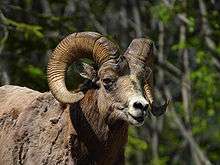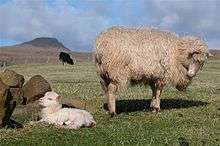Ovis
Ovis is a genus of mammals, part of the Caprinae subfamily of the ruminant family Bovidae.[1] Its five or more highly sociable species are known as sheep. The domestic sheep is one member of the genus, and is thought to be descended from the wild mouflon of central and southwest Asia.
| Sheep | |
|---|---|
 | |
| Bighorn sheep | |
| Scientific classification | |
| Kingdom: | Animalia |
| Phylum: | Chordata |
| Class: | Mammalia |
| Order: | Artiodactyla |
| Family: | Bovidae |
| Subfamily: | Caprinae |
| Genus: | Ovis Linnaeus, 1758 |
| Species | |
|
See text. | |
Terminology
Female sheep are called ewes, males are called rams (sometimes also called bucks or tups), and young sheep are called lambs. The adjective applying to sheep is ovine, and the collective term for sheep is flock or mob. The term herd is also occasionally used in this sense. Many specialist terms relating to domestic sheep are used.
Characteristics
Sheep are fairly small compared to other ungulates; in most species, adults weigh less than 100 kg (220 lb).[2] Males are usually heavier than females by a significant amount. Wild sheep are mostly found in hilly or mountainous habitats. Their diets consist mainly of grasses, as well as other plants and lichens. Like other ruminants, they have four-chambered stomachs, which play a vital role in digesting food; they eructate, and rechew the cud to enable them to digest and live on low-quality, rough plant materials. Sheep conserve water well and can live in fairly dry environments.
The bodies of wild sheep (and some domestic breeds) are covered by a coat of thick hair to protect them from cold. This coat contains long, stiff hairs, called kemps, over a short, woolly undercoat, which grows in autumn and is shed in spring.[3] This woolly undercoat has been developed in many domestic sheep breeds into a fleece of long wool, with selection against kemp hairs in these breeds. The fleece covers the body (in a few breeds also the face and legs) and is used for fibre. Domestic sheep are also kept for their milk and meat (which is called lamb or mutton depending on the age of the animal).
In wild sheep, both rams and ewes have horns, while in domestic sheep (depending upon breed) horns may be present in both rams and ewes, in rams only, or in neither. Rams' horns may be very large – those of a mature bighorn ram can weigh 14 kg (31 lb) – as much as the bones of the rest of its body put together. Rams use their horns to fight with each other for dominance and the right to mate with females. In most cases, they do not injure each other because they hit each other head to head and their curved horns do not strike each other's bodies. They are also protected by having very thick skin and double-layered skulls.[4]
Wild sheep have very keen senses of sight and hearing. When detecting predators, wild sheep most often flee, usually uphill to higher ground. However, they can also fight back. The Dall sheep has been known to butt wolves off the face of cliffs.[4]
Sheep have scent glands on their faces and feet. Communication through the scent glands is not well understood, but is thought to be important for sexual signaling. Males can smell females that are fertile and ready to mate, and rams mark their territories by rubbing scent on rocks.
Species
Six species and numerous subspecies of sheep are currently recognized, although some subspecies have also been considered full species. The main recognized divisions are:[1]
 | Ovis ammon | Argali |
.jpg) | Ovis aries[5] | Domestic sheep |
 | Ovis orientalis orientalis group | Mouflon |
 | Ovis orientalis vignei group | Urial |
 | Ovis canadensis | Bighorn sheep |
 | Ovis dalli | Dall sheep |
_by_Joseph_Smit.jpg) | Ovis nivicola | Snow sheep |
Behaviour
Sheep are social animals and live in groups, called flocks. This helps them to avoid predators and stay warm in cold weather by huddling together. Flocks of sheep need to keep moving to find new grazing areas and more favourable weather as the seasons change. In each flock, a sheep, usually a mature ram, is followed by the others.[3]
Mating

Mating in ovis is characterized by males competing for females in estrus.[6] Social rank in rams is established by male-male competition, known as the rut.[7] Females select from dominant males based on sexually selected characteristics such as body size and horn size, as those traits are desirable in offspring.
Females typically are separate from males outside the rut, however, during the rut females and males are found together.[7] Females that are oestrous isolate themselves from other ewes, and may be less mobile.[7] The rut is also linked with different ewe behaviour than during non-rutting periods.[7] These changes are characterized by decreased feeding, increased time observing their surroundings, and increased behaviour changes.[7] Ewes are also predicted to be slightly receptive to the displays of the rams.[7]
See also
- Aries, the Ram (astrological sign)
- Barbary sheep (Ammotragus lervia), another type of goat antelope, not closely related to Ovis sheep
- Blue sheep or bharal (Pseodois), two species of goat antelopes, not closely related to Ovis
References
- Grubb, P. (2005). "Order Artiodactyla". In Wilson, D.E.; Reeder, D.M (eds.). Mammal Species of the World: A Taxonomic and Geographic Reference (3rd ed.). Johns Hopkins University Press. pp. 707–710. ISBN 978-0-8018-8221-0. OCLC 62265494.
- Nowak, R. M. and J. L. Paradiso. 1983. Walker's Mammals of the World. Baltimore, Maryland: The Johns Hopkins University Press. ISBN 0-8018-2525-3
- Clutton-Brock, J. 1999. A Natural History of Domesticated Mammals. Cambridge, UK : Cambridge University Press ISBN 0-521-63495-4
- Voelker, W. 1986. The Natural History of Living Mammals. Medford, New Jersey: Plexus Publishing, Inc. ISBN 0-937548-08-1
- ICZN (International Commission on Zoological Nomenclature) Opinion 2027
- Coltman, D; Festa-Bianchet, M; Jorgenson, J; Strobeck, C (2002). "Age-Dependent Sexual Selection in Bighorn Rams". Proceedings of the Royal Society B: Biological Sciences. 269 (1487): 165–172. doi:10.1098/rspb.2001.1851. PMC 1690873. PMID 11798432.
- Gonzalez, Georges; Bon, Richard; Estevez, Imna; Recarte, Jose (2001). "Behaviour of Ewes (Ovis Gmelini Musimon x Ovis Sp.) During the Rut". Rev. Ecol. 56: 221–230.
- Bulanskey, S. 1992. The Covenant of the Wild. New York: William Morrow and Company, Inc. ISBN 0-688-09610-7
- Parker, D. 2001. The Sheep Book. Athens, Ohio, USA : Swallow Press / Ohio University Press ISBN 0-8040-1032-3